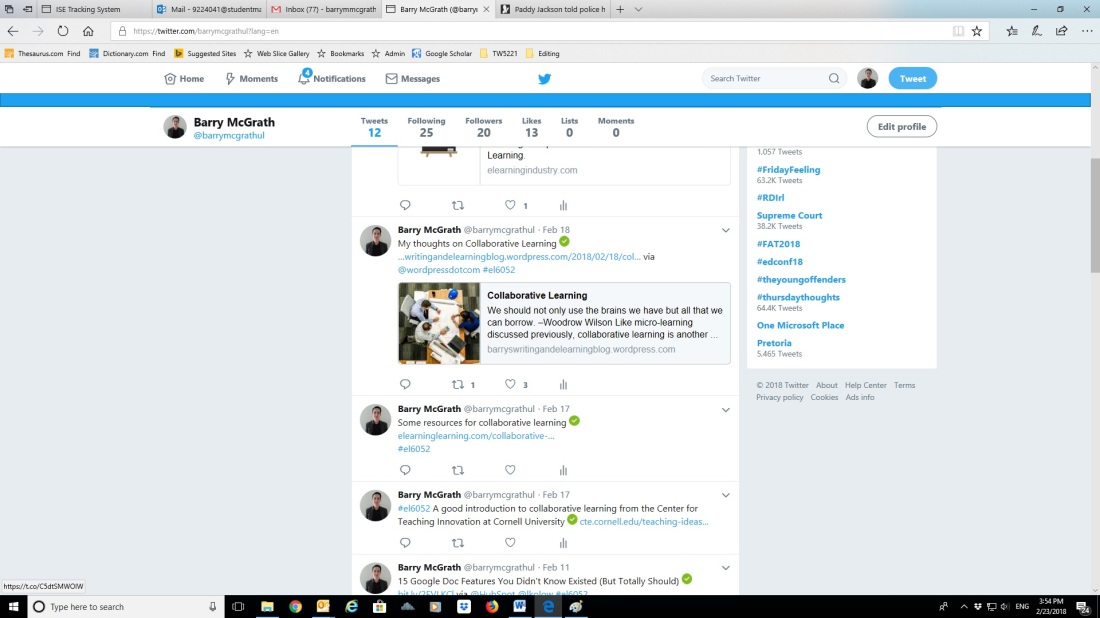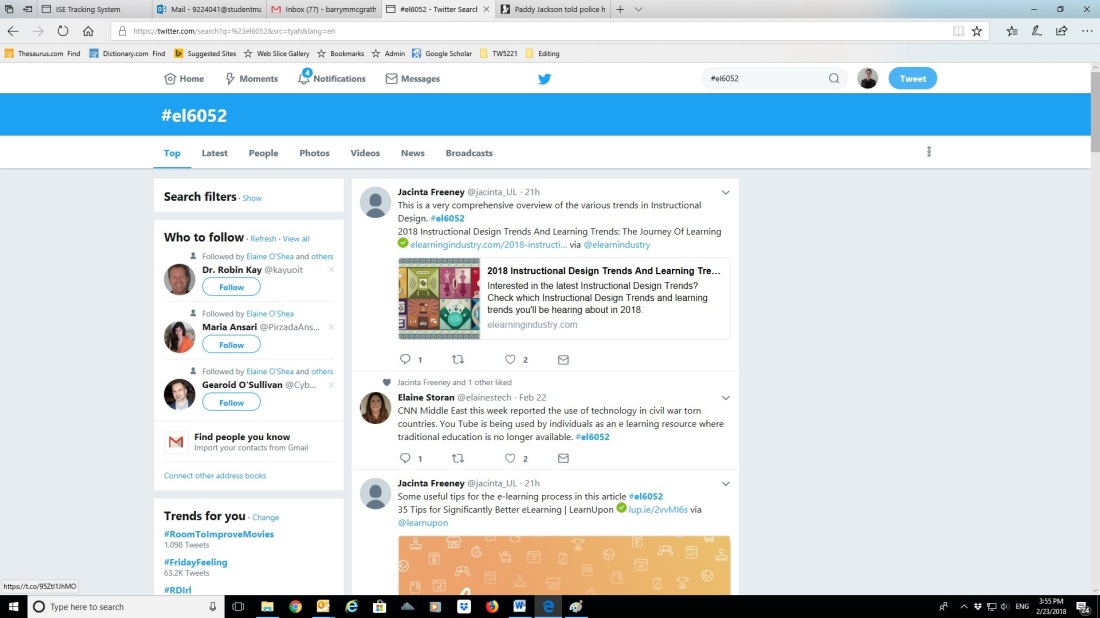Social networking websites like …Twitter…provide an unparalleled ability for people to stay connected in new and unique ways.
– Michael Bennet
In this post, I list the main features of the social network site Twitter, describe my own experiences of using it for e-learning, and conclude with the main advantages and disadvantages of using Twitter in e-learning.

Social network sites like LinkedIn, Facebook, YouTube, and Instagram have become hugely popular in recent years as ways for people to post content online and to interact with one another.
Established in 2006, Twitter is one such social networking site that allows users to post and interact with messages. As of late 2017, Twitter had over 300 million active users globally. Since its inception, Twitter has become a popular tool amongst educators, primarily as it allows rapid communication among many people simultaneously. Educators have adopted this social media phenomenon and use social media widely to connect with current and potential students, and also to communicate instructional content (Ainin et al. 2015; Veletsianos and Kimmins, 2016).
Some of the main features of Twitter include:
– free to use (a valid email address is required to sign up)
– messages or ‘tweets’ are limited to 280 characters (typically a sentence or two with a link[s]; until Nov 2017 this was limited to 140 characters)
Here are some of the tweets I posted recently:

– while tweets are publicly visible, only registered users can post, reply to, and like tweets; unregistered users may only read tweets
– registered users can follow or subscribe to others’ tweets by using the hashtag ‘#’ symbol
– using the hashtag with a particular topic can enable learners or followers to stay informed of the latest information posted online about that topic.
This is an example of a search I performed for one of the classes I am taking this semester (“el6052”). I placed the # symbol before “el6052” in the search box and the results are displayed as follows:

This way I can follow each item that my classmates post about items related to the class “el6052”. Results are displayed with the most recent first and you can scroll down through the list to see older posts.
Twitter is regularly updated and new additional features are frequently added. Pavolivic et al. (2015) highlight some additional extras on Twitter that have proven useful for education. One such application is Twiducate, a free platform that allows teachers to create a private social media platform or virtual classroom, enabling the sharing of links, resources, ideas and so on.
In the past, I had been dismissive of Twitter as being just another social media outlet. It was only until I started using it along with my classmates this past semester that I began to appreciate just how powerful a learning tool it can be. We have been using Twitter to learn about trends, ideas and applications in e-learning. I have learned a great deal these past few weeks from my classmates and huge amounts of information have been shared among us. As the number of characters in each tweet is limited, the text content is usually focused and concise. I can read a tweet and quickly decide if I want to read and learn more about that particular topic or not. The ease of use, rapidity and simplicity of using it are all fantastic features that facilitate learning.
For some great ideas on how to use Twitter in education, read Stephanie Norman’s blog
Some of the main advantages of using Twitter in education include:
– it is free and easy to use
– once an Internet connection is available, it can be accessed anywhere, anyplace and anytime from any device or platform
– suitable for micro-learning
– ideal for collaborative learning
– facilitates rapid discussion of topics
– helps create a community atmosphere
– good way to connect with younger (<30 years) learners
Some downsides of using Twitter for education are:
– limited to 280 characters (currently 140 in Chinese, Japanese and Korean)
– content is not regulated (anyone can post just about any text content) on a particular topic
– content may stray off topic
– limited applications for visual content
In their blogs, Christopher Pappas (2015) and Charlie Osborne (2012) expand on the pros and cons of using Twitter for e-learning purposes.
If you are an instructor interested in using Twitter in your class or for your learners, Steven Anderson has compiled a great Educators’ Guide to Twitter.
If you have any ideas on how to use Twitter for education, or wish to share how you have used Twitter in your class, please leave a comment.
References/Further Reading:
Ainin, S., Naqshbandi, M.M., Mogavvemi, S., and Jaafar, N.I. (2015) ‘Facebook usage, socialization and academic performance.’ Computers & Education, 83, 64–73. [online], available at https://blogs.ubc.ca/georginamartin/files/2014/10/Facebook-usuage-socialization-and-academic-performance.pdf [accessed 21 Feb 2018]
Pavolivic, M., Vugdelija, N. and Kojic, R. (2015), ‘The use of social networks for elearning improvement’, Hellenic Journal of Music Education and Culture, 6, [online], available at: http://hejmec.eu/journal/index.php/HeJMEC/article/viewFile/62/55&hl=ar&sa=X&scisig=AAGBfm2efWX_0-mA0HnBt-Y8t6DiXCrpQA&nossl=1&oi=scholaralrt [accessed 21 Feb 2018]
Veletsianos, G. And Kimmins, R. (2016), ‘Scholars in an increasingly open and digital world: How do education professors and students use Twitter’ , Internet and Higher Education, 30, 1-10, [online], available at:
https://pdfs.semanticscholar.org/63c8/0c79c6d4434da769f51b917040ea626a56cc.pdf
[accessed 21 Feb 2018]
2 thoughts on “Using Twitter for E-Learning”